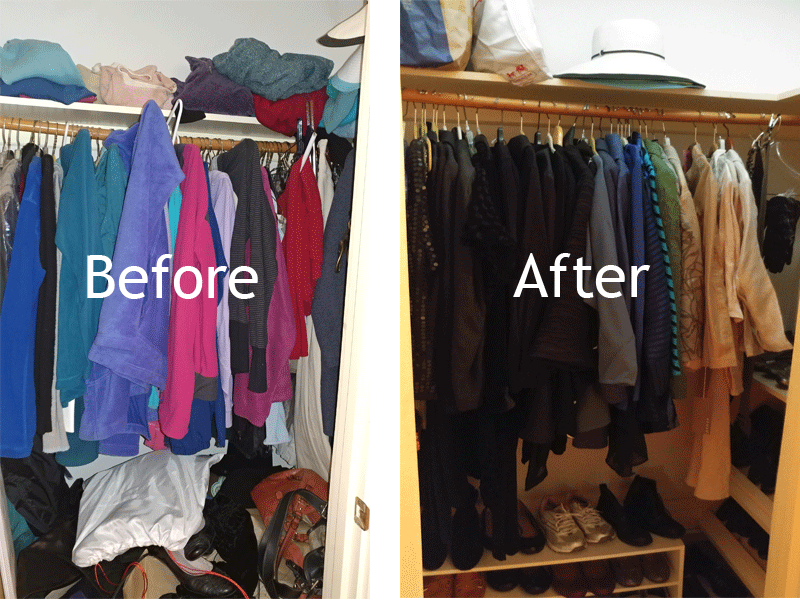Learning how to unpack after moving is one of the best ways to get started on the right foot. Which is the right foot? The organized one!
Read more3 Reasons to Hire Professional Organizers to do the Packing for Your Move
Having an anxiety attack just thinking about packing your stuff up for a move? Packing items prior to a move is one of the top stressors for people moving. There are 3 ways to handle packing: 1 - Do it yourself, and/or recruit friends to help. 2 - Have the moving company do it. 3- Hire professional organizers to do it. Hiring professional organizers to pack for your move saves time, aggravation, and money.
1. Moving companies don't really want to pack your stuff. Movers make money on moving and trucking boxes and furniture. Packing is time-consuming and just not their preferred service offering. Most movers charge by the box for packing services, not by the hour. This means they are more likely to rush when packing, which means that fragile items are more likely to break, the contents of boxes aren't sorted, and the boxes are not accurately labeled.
2. Organizers will take the time to help you declutter before you pack. Why pack and then unpack a bunch of stuff you don't need? It only adds time and expense to the move if you don't declutter ahead of time. Organizers will sort your items and then help you decide what to pack and what to donate or toss. In addition, they will take your items for donation and arrange for trash to be removed.
3. Organizers are paid by the hour and will carefully pack your belongings. They will also take the time to accurately label all the contents of each box and enter it into an inventory sheet so that you can easily find what you need when unpacking.On the other end of your move, you will thank yourself for hiring pro organizers to do the pack. Click here to read more about our move management services.
How to Organize Your Wardrobe the Peaceful Place Way - 7 Steps to Closet Serenity
Peaceful Place uses the Kon-Mari method of organization, as outlined in the bestselling book The Life-Changing Magic of Tidying Up by Marie Kondo - also as seen in her Netflix series. We make modifications and additions to Kon-Mari to suit our clients’ individual needs.The Kon-Mari method is not a 15-minutes-per-day system. It’s a thorough, all-at-once, wholistic approach to organizing which is not quick or easy but is really the only way to ensure that your clothes are organized in a functional way that is easy to use and maintain. If done right, you only need to do this once!How long will you need to organize your clothes? Anywhere from 4 to 8 uninterrupted hours, maybe more if there is a very large number of items. Step 1: Take “before” photos of your closet and drawers. Make your bed to use it as a staging area. Step 2: Bring every single item of clothing you own from wherever it is - your car, the laundry, your basement, your hall closet, your gym bag - into your bedroom. Step 3: Take all your clothing from your drawers, closets, and elsewhere, and do a rough sort into piles by type: jeans, yoga pants, short-sleeved tops, skirts, socks, etc. You may need to break it down into subcategories (long socks, footie socks, etc.), if you have a lot of clothes. Place the piles on the bed and floor. Leave all items on hangers. Don’t forget shoes and accessories like scarves and handbags. Jewelry can be left for another day!Use sticky notes on the walls to keep track of what is in what pile. Step 4: Once you have sorted every item into the appropriate pile, go through each pile, one piece at a time. Check each piece for stains, holes, or damage. Throw away anything not in good condition. Establish some rules for what to keep and what to discard, for example:
You will donate all items in sizes which no longer work for you.
You will donate all items which you haven’t worn in the last year, with the exception of formal dress clothes (for weddings, etc.) which you haven’t had occasion to wear. Keep only your very favorites in this category, though.
You will donate all items which you haven’t worn much because you don’t really like how they fit, feel, function, or look
You will donate all items you have unnecesarry multiples of (for example, you don’t need to keep 7 black tank tops unless you really do wear (and soil) a black tank top 4 times a week.)
If you have ready access to laundry machines, and do your laundry every other week (most people do it much more often), there is no need to own 27 pairs of footie socks, or 30 pairs of underwear. These items take up a lot of space in drawers.
Put all donated clothing directly into a contactor bag. Put all discard clothing into a different bag.
Step 5: Take the sticky notes you used for sorting and placed them on the front of drawers and on the walls of your closet, indicating where each type of item is to go. Use drawer dividers or containers to separate socks from underwear, for example. If your hanging clothes are on wire hangers, rehang them on thin black velvet hangers. Either throw away the wire hangers or save them to take back to the dry cleaners. Hang the clothes so that the hangers curl around the rod from back to front. After you wear an item, hanging it up going from front to back. After a year, you will see what you have really worn. Hang all like items together, arranging their colors from dark to light, left to right. Use closet rod markers to designate Skirts, Pants, Dresses, etc. Accessories which save space in closets: belt hangers, multi skirt hangers, tank top hangers, etc. If there is space, we recommend hanging your sweaters (here is how to hang them so there are no sweater bumps or stretching.)If you need to store folded items such as sweaters or sweatshirts on the top shelf of your closet, purchase some shelf divers to stop them from cascading sideways all the time. Handbags can be stored on the top shelf, like books. Shoes can either go on the floor of the closet or on a shoe rack. It really depends on the layout of the closet. Remember, the goal is to give hanging clothing “swing room” and to not overstuff your drawers. The fewer items you have, the better it will look and work for you.Step 6: Take the trash bags of discarded clothing and wire hangers directly out to your trash area. Take the containers of clothing to be donated and put them into your car with a note taped on it with the address of where it is to be taken, as well as the date and time you are taking it. Step 7: Take an after photo of all your hard work and share it with your friends! Print a copy of your before photo and tape it in a discreet place in your closet to remind you to maintain your organization and not overshop!
To Switch or Not to Switch - 7 reasons to switch out your clothing seasonally (and 7 reasons not to)
Switching out your clothes can double your closet space and takes 4 hours per year.
Read more6 Reasons Why your Clothes Closet and Drawers are a Nightmare
Before organization.
The top 6 reasons why people find themselves in closet chaos are:Keeping clothes for all seasons in the closet instead of switching out clothes seasonally.Overbuying - since they can’t find a certain white blouse, they buy another, and then another. Or buying multiple colors of many items. Or buying items without trying them on and not returning the ones that don’t work.
Read moreHow We Organize Closets & Clothes
Having overstuffed, jumbled closets and drawers causes our clients lots of stress every day. That's why Peaceful Place gets more calls for closet organization from our clients in the Cape Cod and Southeast MA area than for any other area of the house. Most of these jobs require two people from Peaceful Place, and the client only needs to be involved in the middle part of the process.Here's how we organize closets and clothes. We use a slightly modified version of the famous KonMari method. Step 1: We take every item, both wearables (clothing and accessories), and non-wearables out of the closet. Step 2: We repeat Step 1 with all bureaus and dressers which contain clothes. Step 3. We sort all items into like piles, such as: workout clothes, bras, blouses, scarves, jean, pants, dresses etc., putting aide any stained, ripped, or damaged items. Step 4: This is where the client gets involved. We have the client sit down and get comfortable. It is "decision time." We hold up every item of clothing and the client decides whether to keep it or donate it. Generally, about 1/4 to 1/3 of items will need to be downsized in order to make the closet and dressers workable. We can help the client decide what to keep based on their lifestyle. After this (1 to 1.5 hours), the client's work is done. Step 5: We label all the areas of the closet and dressers with where things will go and get client's approval. Step 6: We put everything in its place, using thin black velvet hangers, customized rod markers, shelf dividers, and whichever shoe racks, scarf and belt hangers, drawer organizers, etc. are necessary. Step 7: Time for the big reveal! Afterward, we take all trash to the trash area of the house and take all donations with us. After we drop off the donations to charity, we email the donation receipt to the client for tax purposes. As with all our jobs, the #1 priority is ease of maintenance for the client. Everything must be easy to put back, so that the closet and dressers can stay organized.Depending on how many clothes, this process can take from 4 to 8 hours. To do jewelry is another 1 - 2 hours. Ready to take the plunge and get your closets back? Click here to schedule a free consult call or just call Julie at 508-246-7866.
How to Overhaul your Kitchen Junk Drawer
Peaceful Place recently tackled one of the most common organizational pitfalls: the kitchen junk drawer. Since the kitchen is the most-used room in the house, any stray object finds its way into this spot. The ideal purpose purpose of this drawer is to hold the following types of things:
Office supplies: Pens, pencils, pads of paper, Post-its, tape - if you don't have an office area in your kitchen
Household tools - scissors, tape measure, super glue, small screwdrivers
Pet medicine & supplies
Rubber bands, bag clips, hair elastics
Spare change
First aid - bandaids & ointment
Keys
Chargers
Sunscreen & lip balm
Coupons & gift cards
The trouble comes when people have outdated chargers & keys, and too many of all the above objects. We used containers from the Dollar Store with rubber bottoms to prevent sliding - also, the drawer has a grip liner, always a good idea. An idea for what to do with assorted screws and parts which might go to something, but you're not sure what: Put them in a box with a label to go through it 6 months from now. If you haven't needed it in that time, it's okay to part with it.
What is a home Command Center and do you need one?
What started as a small place to hang keys and sort mail has become a more complex space that functions as an organizational center for household calendars, paperwork, schoolwork, and electronics.
Read more





